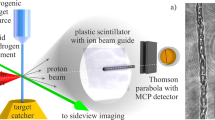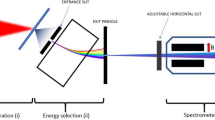Abstract
ELECTRON collection has been obtained in hydrogen up to pressures of about 90 atmospheres. To get the very pure hydrogen needed, a cylindrical ionization chamber was made of glass (12 cm. long ; 5 cm. diameter), with an axial wire (0·2 mm. diameter), for the collecting electrode ; a coating of ‘Aquadag' on the outside of the glass formed a convenient high-voltage electrode. The chamber was very carefully evacuated, baked, sealed off, and then placed in a steel container in which the pressure of hydrogen was slowly raised at the rate of one atmosphere per hour. By means of two heated palladium tubes sealed into the glass chamber, the chamber was slowly filled with purified hydrogen.
This is a preview of subscription content, access via your institution
Access options
Subscribe to this journal
Receive 51 print issues and online access
$199.00 per year
only $3.90 per issue
Buy this article
- Purchase on Springer Link
- Instant access to full article PDF
Prices may be subject to local taxes which are calculated during checkout
Similar content being viewed by others
References
Gibson, W. M., and Livesey, D. L., Proc. Phys. Soc., 60, 523 (1948).
Green, L. L. (private communication).
Freundlich, H. F., et al., Rev. Sci. Instr., 18, 90 (1947).
Maeder, D., Helv. Phys. Acta, 20, 139 (1947).
Author information
Authors and Affiliations
Rights and permissions
About this article
Cite this article
STAFFORD, G. A High-Pressure Hydrogen-filled Ionization Chamber. Nature 162, 771–772 (1948). https://doi.org/10.1038/162771b0
Issue Date:
DOI: https://doi.org/10.1038/162771b0
Comments
By submitting a comment you agree to abide by our Terms and Community Guidelines. If you find something abusive or that does not comply with our terms or guidelines please flag it as inappropriate.



